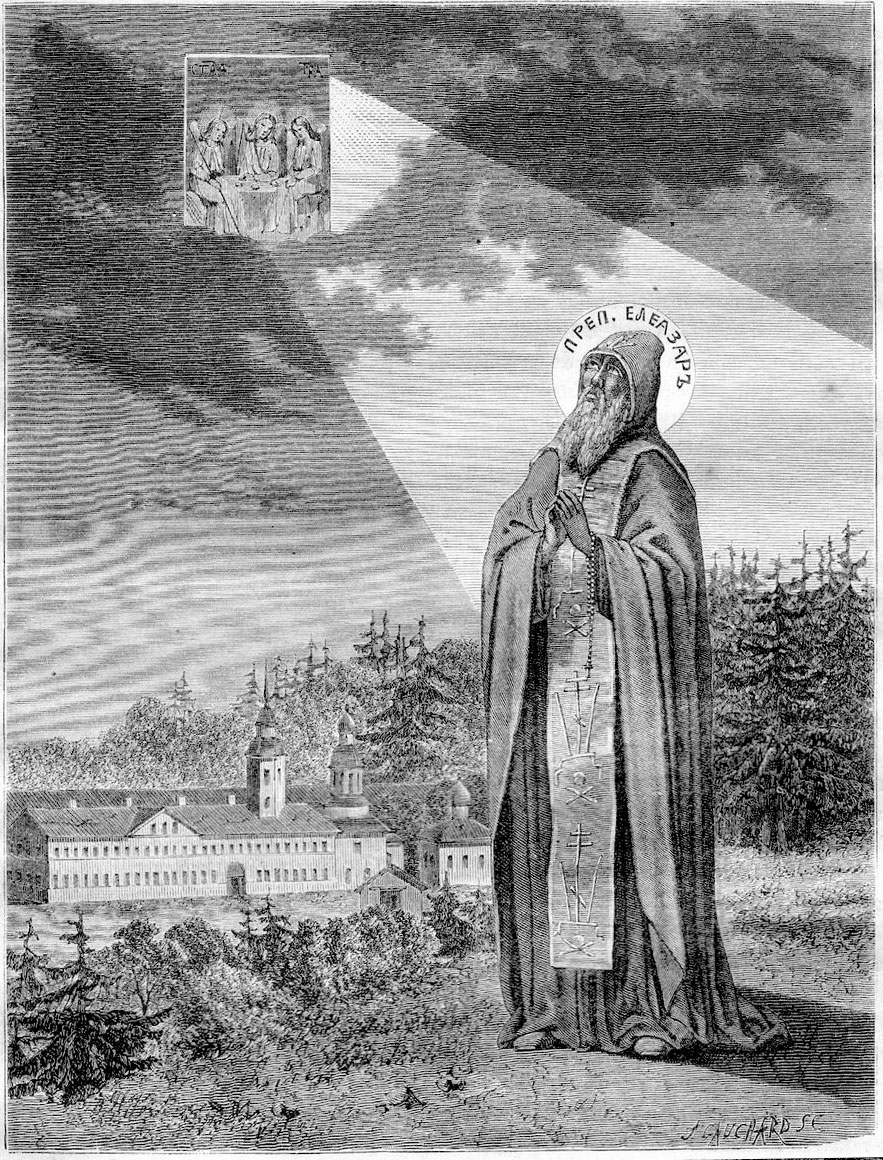Volume 2. Solovki GULAG
Yeleazar Anzerskiy
"The Solovetsky Islands (Russian: Соловецкие острова), or Solovki (Соловки), are an archipelago located in the Onega Bay of the White Sea, Russia. Area: 347 square kilometers (134 sq mi). "
( The Solovki Encyclopedia )
Yeleazar took the habit in the Solovki Monastery in the period between 1606 and 1614.
Yeleazar Anzerskiy
He was born in Kozel'sk to a merchant's family. The male part of his family followed the tradition of withdrawal to the monastery at the end of life. In the monastery Yeleazar showed himself as skillful engraver. At the end of 1614, Yeleazar departed to Anzer Island and settled at the foot of a mountain, which was later named Golgotha. He took up schema and kept to a lifestyle of severe asceticism. He ate only once a week, he bore chains, prayed, read and copied books. After four years, Yeleazar moved to the Trinity Lip of the Anzer Island, where the seafarers since ancient times have found refuge in the foul weather. These seafarers spread the glory about the severe ascetic. People began to come to Yeleazar. Soon a minor-monastery was formed and Yeleazar was elected Father Superior. Conditions of a visit to this minor-monastery were set according to the model of the Athos regulations of divine services: "no names, obedience, silence, patience in grief, fasting and prayer."
Friendship of Yeleazar with Aleksandr Bulatnikov (former solovki monk, and later the godparent and adviser of tsar Mikhail Fedorovich) led to tsar being told of the exploits of this hermit. There is a legend that Yeleazar made a prediction of birth of the heir (Aleksey Mikhaylovich). Similar legends were widespread in 16th and 17th centuries all over Russia (for example, about Cornelii Komel'skii or Nektarii – the Father Superior of Nilovo-Stolobenskaya hermit). In 1628, in Moscow, Yeleazar obtained a tsarist granted letter. He refused the opportunity of a church career and came back to Anzer. From this time, Yeleazar fought to obtain of independence from the Solovetsky Monastery.
On July 31, 1633, the minor-monastery got independence from the cloister, giving birth to decades of confrontation with the Solovetsky Monastery. In 1636, three monks came to Yeleazar. They were to become his dear pupils. Apparently, because of the concerns connected with preserving the independence of the minor-monastery, Yeleazar named them by warlike names: Nikifor ("vanquisher"), Nicodemius (the "conquering people") and Nikon ("conqueror").
 Nikon (Nikita Minov) is known historically as the power-loving Moscow patriarch, who created a schism in the Russian church because of his insistence as to the proper formation of the sign of the cross with fingers of the right hand and also of letters in the word "Jesus".
Nikon (Nikita Minov) is known historically as the power-loving Moscow patriarch, who created a schism in the Russian church because of his insistence as to the proper formation of the sign of the cross with fingers of the right hand and also of letters in the word "Jesus".
Teachers love pupils who emulate them. From one side, Yeleazar devoted himself to the withdrawal from worldly vanity to ascetics. On the other hand, the thirst of authority reflected in his concerns about the independence of the minor-monastery. Yeleazar issued his own biography, desiring to tell the world about himself. It was an innovation in the Russian monastery culture. The wideness, the power, the greatness of Yeleazar reflected in his pupils.
During the years of "Solovki Siege", when the second dear pupil (Nicodemius) was the head of the cloister on the Anzer Island, the monks of the minor-monastery supported those who had risen up. Apparently, it was done to continue and creatively develop the teaching of Yeleazar. It is not our right to judge whether or not the pupils of Yeleazar were acting correctly. We live in a society, formed by behavior of the personalities, which have been influenced by the motion of history. Sometimes this influence is explicit. For example, Nikon himself. But we often do not think where this personality appeared from and whose principles this man personifies..
Yeleazar died in January 13, 1656. He was buried in Trinity Church of the Anzer island.
Поделиться в социальных сетях
